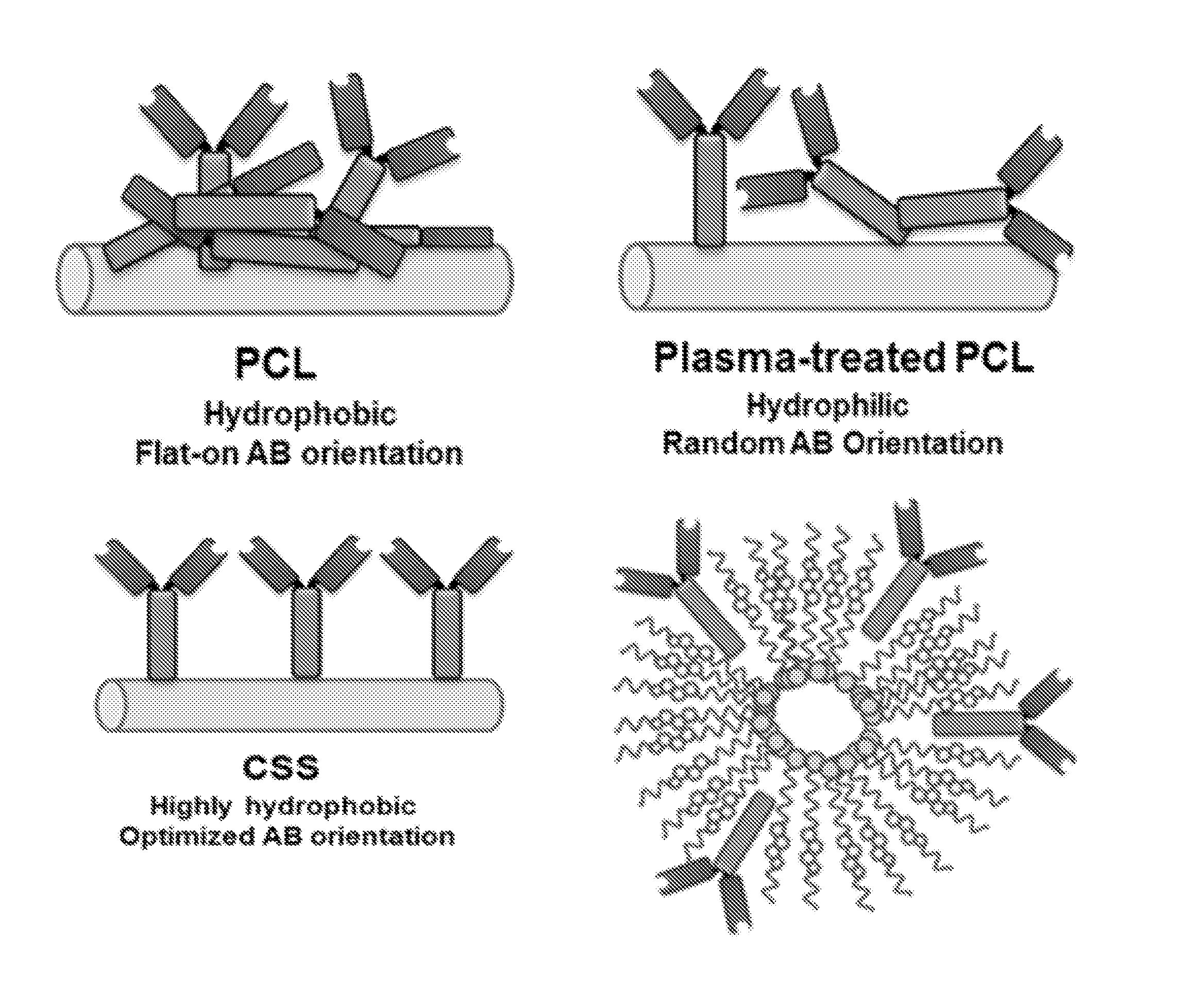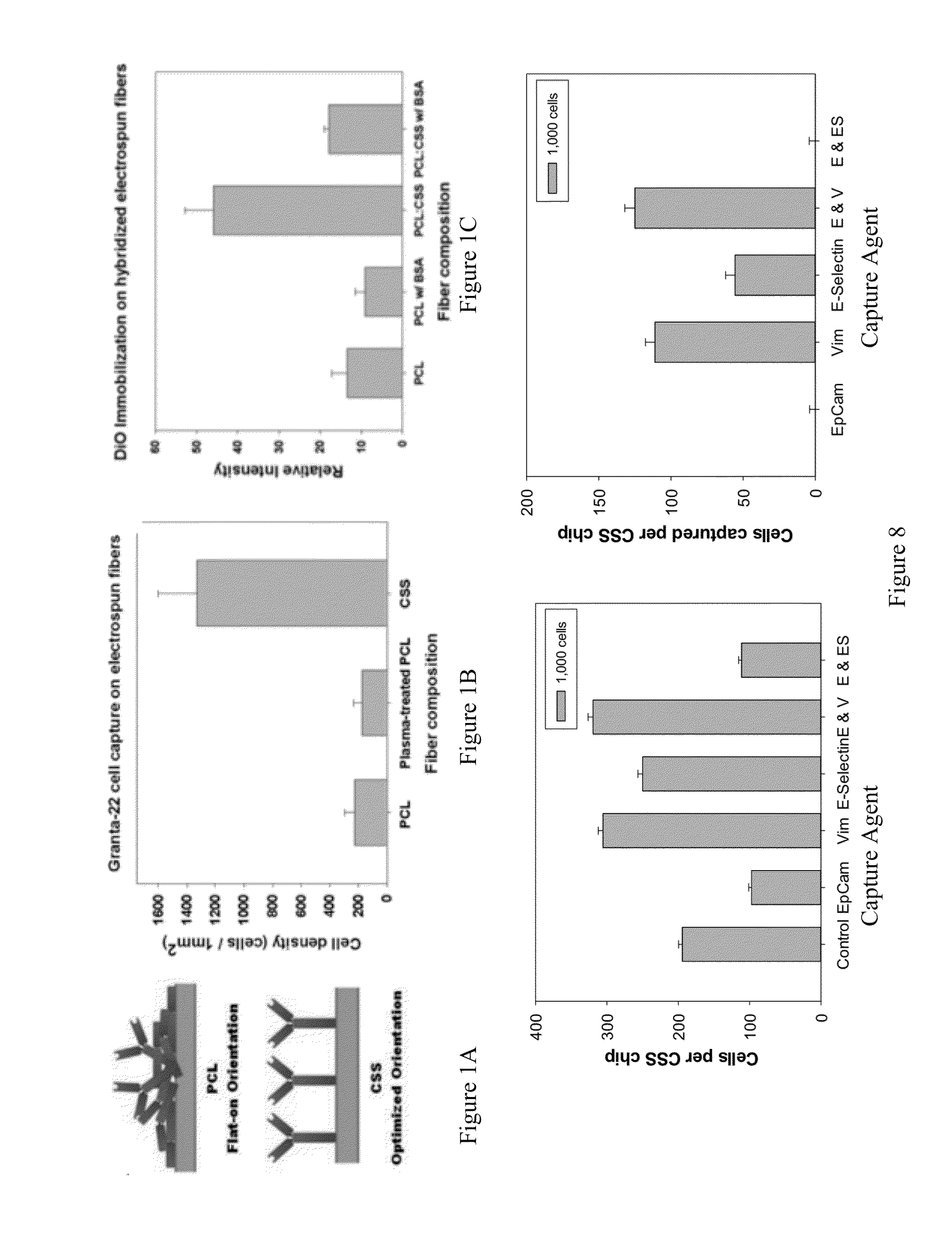Cholesteryl Succinyl Silane Bound Proteins and Methods For Producing and Using the Same
a technology of cholesteryl succinyl silane and bound proteins, which is applied in the field of nonwoven polymer fibers, can solve the problems of fewer than 5% of the binding site available for antigen capture, relatively ineffective detection systems, and protein denaturation, and achieves the effects of fast and cheap fabrication, and promotes cellular migration
- Summary
- Abstract
- Description
- Claims
- Application Information
AI Technical Summary
Benefits of technology
Problems solved by technology
Method used
Image
Examples
example 1
Antibody Immobilization Using CSS
[0061]The ability to capture circulating tumor cells (CTCs) provides valuable insight to personalizing cancer treatments. These tumor cells can be captured by functionalizing surfaces with antibodies specific to CTCs. An ideal cell-capturing platform should, in theory, encourage the anchoring of a monolayer of well-oriented antibodies while minimizing the probability of direct cell-scaffold adhesion. Conventional methods rely heavily on hydrophobic interactions for surface functionalization, leading to protein denaturation and loss of function. This example illustrates that engineered cholestryl succinyl silane (CSS) nanostructures can be used to immobilize antibodies in a manner that significantly improves antibody orientation and function. Without being bound by any theory, it is also believed that these cholesterol-based nanostructures significantly reduce or even eliminate direct cell-scaffold interaction, thereby minimizing the risk of non-speci...
example 2
PCL: CSS Fibers
[0088]In this example, PCL fibers were formed by electrospin process using a 10% w / v PCL solution. In some instances, the resulting PCL fibers were treated with air-plasma for 10 minutes. And the air-plasma treated fibers were contacted (or incubated) with (i) polymerized CSS, in which CSS was polymerized on its own overnight, and the resulting solution was then incubated with plasma-treated PCL fibers overnight, or (ii) CSS monomers, in which a solution of CSS (0.1%, 1% or 5%) monomer was allowed to form nanostructure CSS on PCL fiber overnight.
[0089]Experiment similar to that in Example 1 was performed with DiO to determine simulated protein immobilization. The results are shown in FIG. 6, where PCL is air-plasma treated PCL, CSSp is air-treated PCL incubated with CSS polymer, and CSSm is air-treated PCL incubated with CSS monomer.
[0090]Cell capture experiments were conducted by immobilizing antibody (αCD20) to capture Granta-22 B-cell lymphomas in PCL polymer, PCL ...
example 3
Three-Dimensional In Vitro Tissue Construct for Complex Cell Studies
[0093]In vitro cell studies are typically performed on a 2D platform (such as tissue culture plates). These platforms give scientists a poor idea of how cells interact within their native 3D environments. Currently matrigels are commercially available that allow for 3D cell seeding. However, these matrigels often lack the micro- and nano-structures that are present within natural tissue samples. The lack of a well-engineered 3D construct for in vitro cell studies often make animal studies necessary, significantly increasing study costs while not ensuring accurate insight for disease states that occur in vivo. To overcome these shortcomings, the present inventors have have engineered a three dimensional construct that: 1) is easy to fabricate, 2) is cheap to produce, and 3) can provide a platform for multiple cell types to interact in a manner that is more indicative to in vivo tissue environments.
[0094]The three-dim...
PUM
 Login to View More
Login to View More Abstract
Description
Claims
Application Information
 Login to View More
Login to View More - R&D
- Intellectual Property
- Life Sciences
- Materials
- Tech Scout
- Unparalleled Data Quality
- Higher Quality Content
- 60% Fewer Hallucinations
Browse by: Latest US Patents, China's latest patents, Technical Efficacy Thesaurus, Application Domain, Technology Topic, Popular Technical Reports.
© 2025 PatSnap. All rights reserved.Legal|Privacy policy|Modern Slavery Act Transparency Statement|Sitemap|About US| Contact US: help@patsnap.com



